
CF Snowbirds - Hamilton Air Show 1998(?)
Air shows are another photographic interest of mine -- maybe even one of the first. It was for an air show that I managed to borrow a camera back in University, and it was an air show that made me decide to pursue photography more seriously as a hobby. Without further ado, here is a collection of shots to illustrate the skills I have learned while shooting objects speeding through the air.
Things that spin should look like they’re spinning
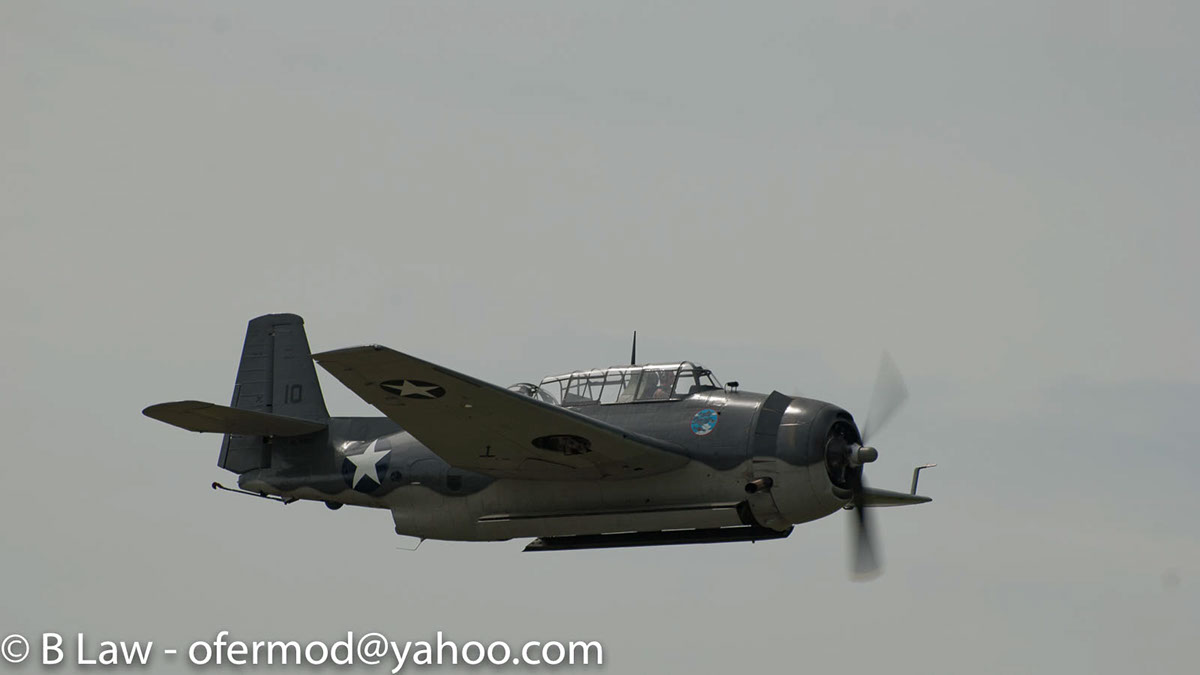
TBM Avenger - Hamilton Air Show 2012
If you read my article on Motorsport Photography, then the same essential skill for panning applies here -- pan your shot along the aircraft's movement. Planes are a little more difficult since they often move a lot faster and in more directions than cars. Keep your shutter speed up to prevent blur, however, just as in cars where you want to see the wheels moving, propeller driven planes should appear to have their propellers spinning. I typically close down my aperture a few stops to slow down the shutter speed when a prop driven plane comes into view -- fortunately they also move slower. Jets, without exposed moving parts, make the shutter speed essentially a non-issue.

Heavy Metal Jet Team MiG 17 - Canadian International Air Show - 2011
If you can't turn down the ISO any more, then your recourse is to close down the aperture to help decrease your shutter speed for prop-driven planes, but the big down-side is that any dust on your sensor really starts to show up, particularly against the bright sky. Either make doubly sure your sensor is clean before going to the air show, or be ready with the healing brush after you get home.
Show the ground when possible

CF86 Sabre - Hamilton International Air Show 2012
There is very little sense of speed when shooting aircraft when the only background is the sky. It is also very unlikely that you will have a higher vantage on aircraft in flight. Still, every opportunity to get a shot with some part of the ground in view gives the plane more of a sense of speed. Again, the pan and a slower shutter allows the ground elements to blur in order to sell the sense of motion.

Mike Wiskus - Canadian International Air Show 2010
And if a stunt pilot is crazy enough to side-slip this close to the water, I'm more than happy to oblige with a photo. There's even his reflection in the water.

Pete McLeod - Canadian International Air Show 2012
If you can get a landmark in shot, in this case the foot bridge at the mouth of the Humber River in Toronto, then by all means.
Smoke makes your work really easy

RCAF Snowbirds - Hamilton International Air Show 2012
Aircraft deliberately blowing smoke makes your job of capturing motion easy -- just remember to frame the smoke trail as a part of your shot. Often a simple arc is enough to convey a sense of motion. Even a point-and-shoot camera with its slower focus and shutter activation is adequate for capturing the motion of aircraft in flight.

Mike Goulian - Canadian International Air Show 2009

Mike Wiskus - Waterloo Air Show 2014
For stunt flyers, catching a decent corkscrew can help show that they are putting on a show.

RCAF Snowbirds - Canadian International Air Show 2012

Kent Pietsch - Canadian International Air Show 2013
However, even simple lines are enough to draw your attention to the real subject of the photo.

CF Snowbirds - Hamilton Air Show 2012
Tight formation flying results in nice parallel smoke trails.

RCAF Snowbirds - Canadian International Air Show 2015
And as the lines start to diverge, then you know that the squad is ready for a manoeuvre.

Heavy Metal Jet Team - Canadian International Air Show 2011

Canadian Harvard Aerobatic Team - Canadian International Air Show 2012
A bit obscured?

Breitling Jet Team - Canadian International Air Show 2015
Teams flying through their own smoke can add a sense of depth to the photo.

Julie Clark - Canadian International Air Show 2008
Flares adding more smoke to this manoeuvre.

Mike Wiskus - Waterloo Air Show 2014
Wiskus again, frighteningly close to the ground. The smoke only adds to the effect. Combined with the right shutter speed, we get a sense of speed and action.
Remember that planes are mechanical marvels

FG-1D Corsair - Canadian International Air Show 2010
As planes go faster, they become shape changers as flaps, landing gear, probes, and hooks emerge from their streamlined bodies. At a good air show, the plane will often fly low and slow so you can get a good look at these features.

CF 18 Hornet - Canadian International Air Show 2010
Landing Gear, Arrestor Hook, and Fuel probe deployed for our viewing pleasure.

A10 Thunderbolt II - Canadian International Air Show 2011
Other planes feature very specific roles and features. It's always more interesting to see a plane do its thing than just a straight fly-by.
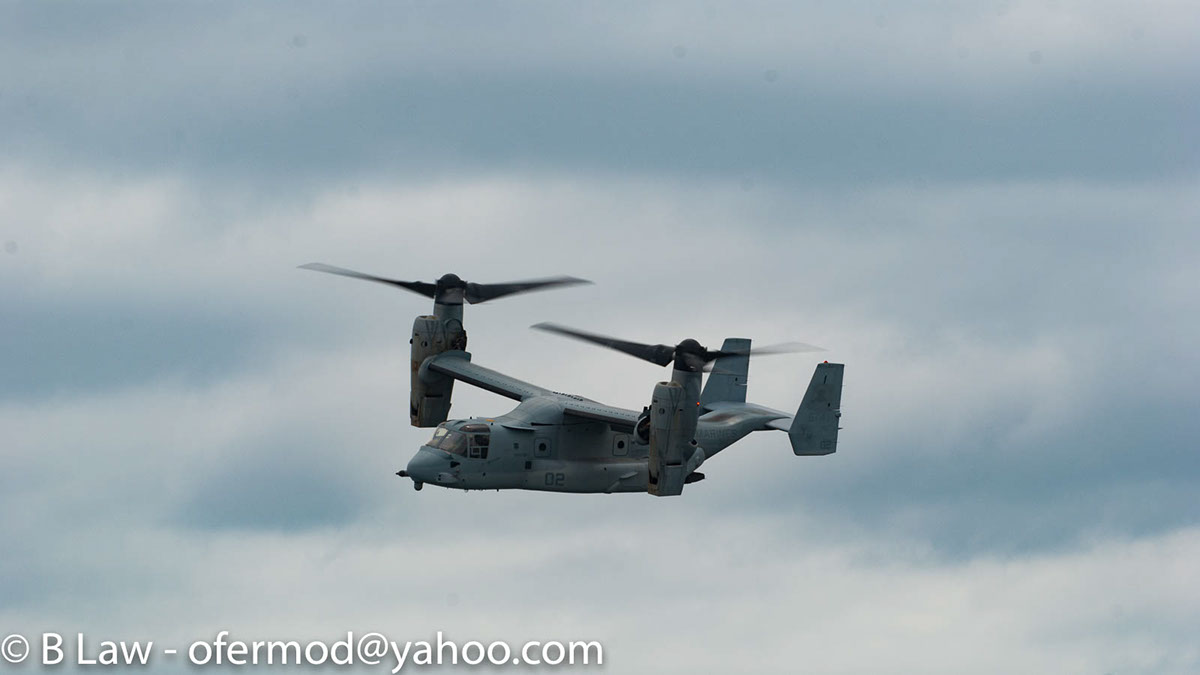
MV-22 Osprey - Canadian International Air Show 2011
The Osprey has turning rotors which allow it to fly vertically like a helicopter, or swing them forward and fly like a plane.

Avro Lancaster - Canadian International Air Show 2011
The Lancaster bomber with its bay doors open. A dark plane with against a bright sky.

CP-140 Aurora - Hamilton Air Show 2012
The underbelly of an Aurora reconnaisance plane -- flaps open and gear down for a low speed pass.

CL-415 Water Bomber - Canadian International Air Show 2008
A water bomber, of course, scoops water and dumps it out to fight forest fires. An early photo with my point-and-shoot, hence the static propellors. There hasn't been a water bomber demonstration at the Canadian International Air Show in some time.

BAe Sea Harrier - Canadian International Air Show 2013
The Harrier, of course, is a jet that can fly vertically. If only it would have come a little lower.
Appreciate the classics
While extremely numerous in their heyday, there are few war era machines left in flying condition. It takes a lot of volunteer effort and donations to keep these machines flying, so I'm always drawn to the classics whenever they take to the air.
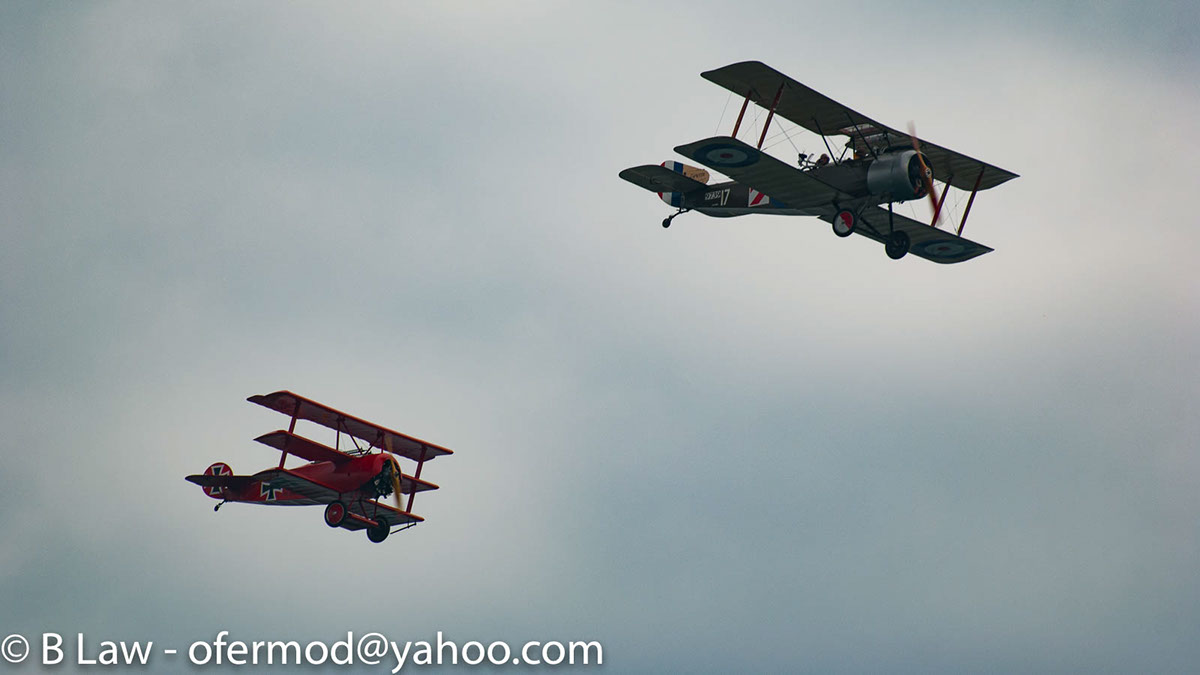
Fokker Dr.I, Sopwith 1/2 Strutter - Canadian International Air Show 2013
World War I era planes.

B29 Superfortress - Hamilton Air Show 2012
This is the last B29 that is still air-worthy.

B-17 Flying Fortress - Waterloo Air Show 2014
There are about a dozen B-17s still flying. Considering the thousands that went to war, that's not very many.
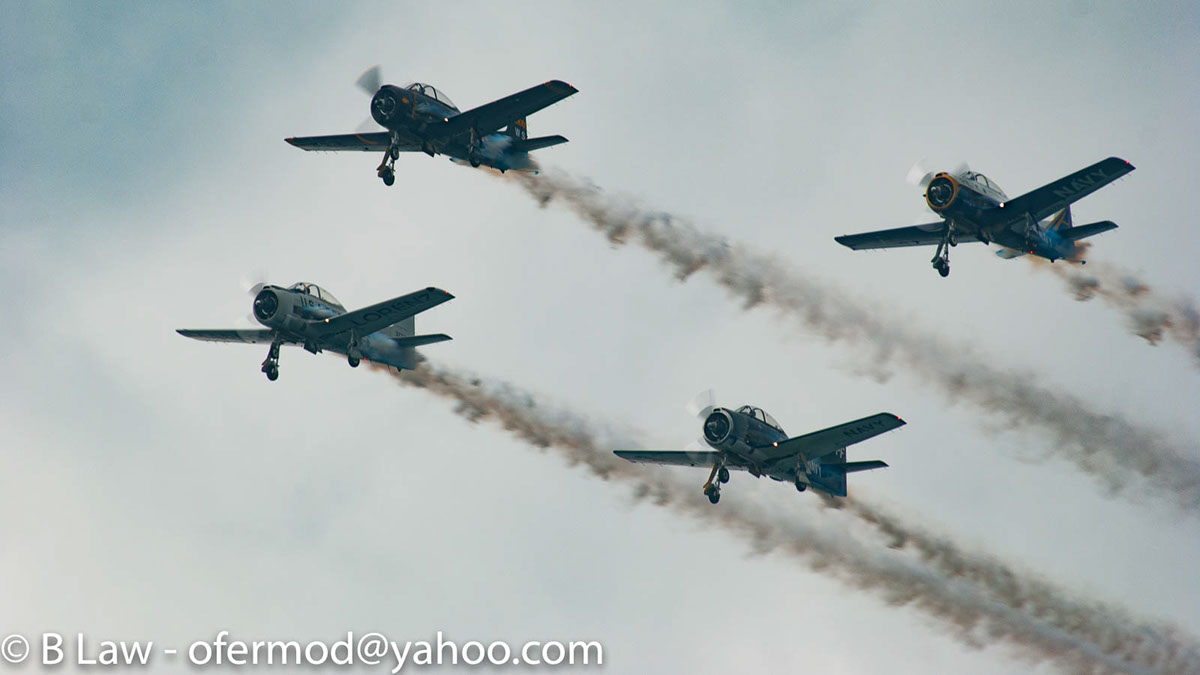
T-28 Trojans - Canadian International Air Show 2013
Upsides and downsides of haze
The heat of summer makes for challenging shots -- as aircraft are more distant, denser humid air starts to obscure the features you are hoping to capture. This often results in lot of post-processing to try and bring all the detail back out for each shot.

CF-18 Hornet - Canadian International Air Show 2013
On the up-side, the increased humidity leads to interesting contrails and vapour build-up as jets go through their manoeuvres. This adds interesting detail and sometimes a sense of speed to an otherwise static looking jet shot at a high shutter speed.

F-22 Raptor - Canadian International Air Show 2009
There is some critical speed at which the humidity just condenses into a visible vapour -- I'm sure it's not the sound barrier.

CT-130 Hercules "Fat Albert" - Canadian International Air Show 2009
It was so humid, you can see the spiral contrails off the propellers.
So, how to expose for planes in flight?
I actually don't know the answer to this. It's actually quite a challenge since it's quite often too bright to check the results on your digital camera, and account for the intervening haze. Also, the actual plane ends up so little of the frame that even the histogram doesn't help determine if you get all the detail you want. So, shooting RAW is a must, and I end up spending a lot of time in post-processing to get something decent.
More often than not, I end up over-exposing. I keep to centre weighted metering and hope that the aircraft gets properly exposed and the sky can get a bit blown out.
There is one year that I under-exposed an entire air show. This got me more sky detail, but I had to drag a lot of aircraft detail out of the shadows. Depending on the camera, this may not be ideal either.
There is one year that I under-exposed an entire air show. This got me more sky detail, but I had to drag a lot of aircraft detail out of the shadows. Depending on the camera, this may not be ideal either.

US Navy Blue Angels - Canadian International Air Show 2009
Weather is really the factor that you can't control. It's either too hazy which obscures your detail, too overcast (or even rainy) which obscures all the wonderful smoke. Too sunny is just uncomfortable and you have to manage your own UV exposure -- and that's before I complain about back-lighting. My favourite is partly cloudy -- at least there is a background that's not completely homogeneous.
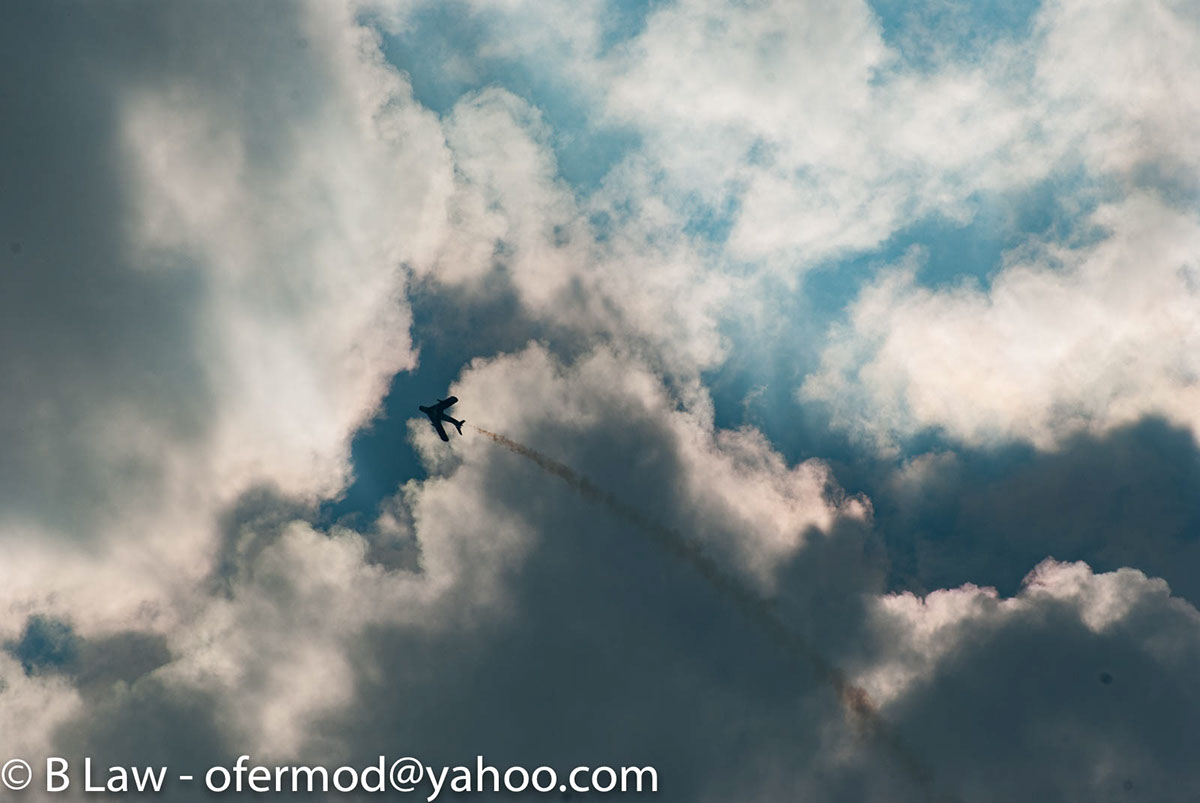
Heavy Metal Jet Team - MiG-17 - Canadian International Air Show 2011

Canadian Harvard Aerobatic Team - Canadian International Air Show 2010
Here's a photo I've used as a desktop background on several occasions. It leaves a lot of empty space for icons, and gets the planes pretty well side on. The Harvards are easy to shoot with their smoke trails and relatively low speeds, so there is a lot of wallpaper potential here.
Framing and cropping
The general rule may be to frame your subject facing into frame in order to draw the viewer into the picture, but for action, it is almost always the opposite -- planes want to burst out of frame. After all, the usual rule just isn't going to work if you are also capturing the smoke trail from an interesting manoeuvre.

RCAF Snowbirds - Waterloo Air Show 2014

Mike Wiskus - Canadian International Air Show 2013
I often don't crop for various reasons, but I've taken to cropping a lot of my air show photos to a 16:9 ratio. I think it just looks more cinematic, and it's an opportunity to chop away some extra sky. Since cameras have so many megapixels these days, you can almost crop at will to get the framing just the way you like. It's still hard to track fast moving objects in the sky, so you might get a perfect subject with a less than ideal framing and just live with it.

CF-18 Hornet - Waterloo Air Show 2014
A tight shot of the Hornet retracting its landing gear.

Kent Pietsch- Waterloo Air Show 2014
Kent Pietsch attempting a camper-top landing -- again demonstrating how fundamental panning can be.
I hope you enjoyed this little photo essay. It’s a tad long, but I hope the information was worth it.
If the pictures seem a little over-processed; it’s actually my first project processed using Lightroom instead of Aperture. Still getting the hang of it.
If the pictures seem a little over-processed; it’s actually my first project processed using Lightroom instead of Aperture. Still getting the hang of it.
